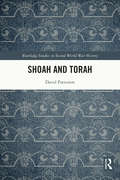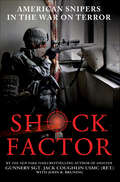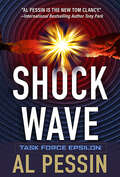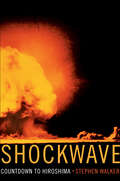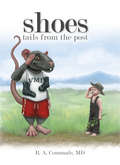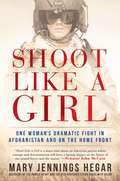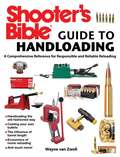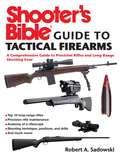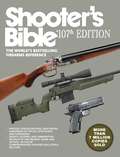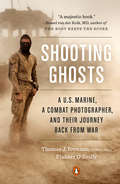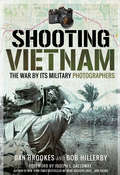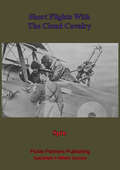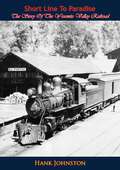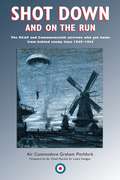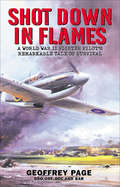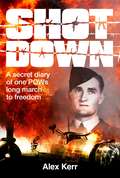- Table View
- List View
Shipyard Girls Under the Mistletoe: The Shipyard Girls Series Book 11
by Nancy RevellTHE ELEVENTH NOVEL IN THE BESTSELLING SHIPYARD GIRLS SERIESSunderland, 1944As the promise of victory draws closer, this Christmas will surely be one to remember.It should be a magical time for Dorothy, who has just been proposed to by her sweetheart Toby. But with each day that passes, Dorothy's feelings for someone else are growing stronger. Now she has an impossible choice to make.Gloria is thrilled that her sweetheart Jack is finally home after more than two years away. But his past is continuing to catch up with them both - creating untold heartache for Gloria and everyone she holds dear.Meanwhile Helen must contend with the fall-out of a shocking family secret that has repercussions for all the Shipyard Girls, while holding out hope for her own happy ending...Can a little festive magic help them win the day?___________________________________________Praise for Nancy Revell:'Nancy Revell knows how to stir the passions and soothe the heart!' Northern Echo'Stirring and heartfelt storytelling' Peterborough Evening Telegraph'Emotional and gripping' Take a Break
Shoah and Torah (Routledge Studies in Second World War History)
by David PattersonShoah and Torah systematically takes up the task of reading the Shoah through the lens of the Torah and the Torah through the lens of the Shoah.The investigation rests upon (1) the metaphysical standing that the Nazis ascribed to the Torah, (2) the obliteration of the Torah in the extermination of the Jews, (3) the significance of the Torah for an understanding of the Shoah, and (4) the significance of the Shoah for an understanding of the Torah.The basis for the inquiry lies not in the content of a certain belief but in the categories of a certain mode of thought. Distinct from all other studies, this book is grounded in the categories of Jewish thought and Judaism—the categories of creation, revelation, and redemption—that the Nazis sought to obliterate in the Shoah.Thus, the investigation is itself a response to the Nazi project of the extermination of the Jews and the millennial testimony of the Jews to the Torah.
Shock Factor: American Snipers in the War on Terror
by Jack Coughlin John R. BruningFrom the author of the New York Times bestselling memoir Shooter comes jack Coughlin's riveting narrative of how snipers have changed the course of America's war on al Qaida in the Middle East and Africa.Retired Marine sniper Jack Coughlin (Shooter) and John Bruning pull back the curtain of secrecy to take an insider's look at the dark and misunderstood world of America's sniper force. Long considered the redheaded stepchildren of the infantry, snipers have been loathed by their fellow warriors, called "ten cent killers" by our media, and portrayed as unbalanced psychopaths by Hollywood. Coughlin and Bruning explore the lives and careers of some of America's most effective snipers during key missions, moments and campaigns in the War on Terror. Part page-turning thriller, part deeply human drama, Shock Factor takes you from the streets of the modern day "Stalingrad" of Ramadi to the skyscrapers of Baghdad as America's one-shot warriors fight desperate battles against all odds, find themselves at the heart of tense international incidents, stalk key enemy leaders, and discover horrific human rights abuses perpetrated by our own allies. Based on extensive interviews with snipers currently on active duty, Shock Factor's gripping accounts of harrowing combat, buried truths and secrets revealed could only be told by snipers to a trusted member of their own elite and cloistered brotherhood.
Shock Wave (A Task Force Epsilon Thriller #3)
by Al PessinA MISSION TO AVERT WARVital seaports in Jordan and Israel erupt in fire and destruction. It&’s the first strike from a terrorist organization determined to increase hostilities throughout the Middle East. There&’s only one way to combat the threat. It&’s time for Operation Shock Wave . . . Saddiq Mohammed al-Assali is America&’s most wanted terrorist. His cells in Israeli and the Palestinian territories are ready and eager to usher in a maelstrom of violence between the two nations. Each will blame the other. Iran will be implicated. And the United States will be drawn into yet another Middle Eastern war. To stop al-Assali, the Defense Intelligence Agency&’s Bridget Davenport assigns Lieutenant Faraz Abdallah to infiltrate the terrorist&’s cabal. But as Faraz uncovers and sabotages al-Assali&’s plans one by one, Bridget herself becomes the target—and Faraz must take decisive action in a deadly game of international deceit . . . &“An authentic, heart-stopping thriller. Don't miss this one!&”—Andrews and Wilson, authors of the Tier One thriller series&“Relentless tension, a fast-paced story . . . military drama at its finest!&” —Carole Stivers, author of The Mother Code&“Al Pessin is the perfect blend of Daniel Silva and Lee Child.&” —Dave Zeltserman, award-winning author of the Julius Katz stories
Shockwave: Countdown to Hiroshima
by Stephen WalkerA riveting, minute-by-minute account of the momentous event that changed our world forever On a quiet Monday morning in August 1945, a five-ton bomb--dubbed "Little Boy" by its creators--was dropped from an American plane onto the Japanese city of Hiroshima. On that day, a firestorm of previously unimagined power was unleashed on a vibrant metropolis of 300,000 people, leaving one third of its population dead, its buildings and landmarks incinerated. It was the terrifying dawn of the Atomic Age, spawning decades of paranoia, mistrust, and a widespread and very real fear of the potential annihilation of the human race. repercussions can be felt to this very day.
Shockwave: Countdown to Hiroshima
by Stephen WalkerA riveting, minute-by-minute account of the World War II bombing of Hiroshima, from early testing to the cataclysmic event and its aftermath.On a quiet Monday morning in August 1945, a five-ton bomb—dubbed Little Boy by its creators—was dropped from an American plane onto the Japanese city of Hiroshima. On that day, a firestorm of previously unimagined power was unleashed on a vibrant metropolis of 300,000 people, leaving one third of its population dead, its buildings and landmarks incinerated. It was the terrifying dawn of the Atomic Age, spawning decades of paranoia, mistrust, and a widespread and very real fear of the potential annihilation of humanity.Author Stephen Walker brilliantly recreates the three terrible weeks leading up to the wartime detonation of the atomic bomb—from the first successful test in the New Mexico desert to the cataclysm and its aftermath—presenting the story through the eyes of the pilots, scientists, civilian victims, and world leaders who stood at the center of earth-shattering drama. It is a startling, moving, frightening, and remarkable portrait of an extraordinary event—a shockwave whose repercussions can be felt to this very day.
Shoes for Anthony: A Novel
by Emma KennedyThis 1944 World War Two drama tells the story of Anthony, a boy living in a deprived Welsh village, anticipating the arrival of American troops. Suddenly, a German plane crashes into the village mountain. A Polish prisoner-of-war survives and is brought into the community where he builds a close relationship with Anthony. Later, the villagers discover one of the Germans on the plane has survived and is still on the mountain.Joyous, thrilling, and nostalgic, Emma Kennedy’s Shoes For Anthony will have you wiping your eyes one moment and beaming from ear-to-ear the next. This is a small gem of a novel that reviewers (and readers) will cherish.
Shoes: Tails from the Post
by R. A. ComunaleAugustus "Gus" Belmont was your typical commercial airline pilot. Late 40s, divorced with one kid, he lived life as he saw it. The only problem: he was dying. And, Gus was a Rat. Kristin Belmont was Gus's daughter--smart, beautiful, a college senior with the entire world ahead of her. She was not a Rat--though she could see and talk with ghosts. Gus faced his mortality with ticked off stoicism, but he really wanted closure for two 25-year-old mysteries: Why did his one true love disappear before their marriage? Was he guilty of causing another Rat's death? Shoes contains love, murder, mystery, ghosts, the Civil War and Vietnam, and a soupçon of the great military college, Virginia Military Institute with its Brother Rat Cadet Corps.
Shoestring Soldiers
by Andrew IarocciThe Great War was a pivotal experience for twentieth-century Canada. Shoestring Soldiers is the first scholarly study since 1938 to focus exclusively on Canada's initial overseas experience from late 1914 to the end of 1915.In this exciting new work, Andrew Iarocci challenges the dominant view that the 1st Canadian Division was poorly prepared for war in 1914, and less than effective during battles in 1915. He examines the first generations of men to serve overseas with the division: their training, leadership, morale, and combat operations from Salisbury Plain to the Ypres Salient, from the La Bassée Canal to Ploegsteert Wood. Iarocci contends that setbacks and high losses in battle were not so much the products of poor training and weak leadership as they were of inadequate material resources on the Western Front.Shoestring Soldiers incorporates a wealth of research material from official documents, soldiers' letters and diaries, and the battlefields themselves, surveyed extensively by the author. It marks an important contribution to the growing body of literature on Canada in the First World War.
Shoot Like a Girl: One Woman's Dramatic Fight in Afghanistan and on the Home Front
by Mary Jennings HegarOn June 29, 2009, Air National Guard major Mary Jennings “MJ” Hegar was shot down while on a Medevac mission on her third tour in Afghanistan. Despite being wounded, she fought the enemy and saved the lives of her crew and their patients. But soon she would face a new battle: to give women who serve on the front lines the credit they deserve. . . . After being commissioned into the U.S. Air Force, MJ Hegar was selected for pilot training by the Air National Guard, finished at the top of her class, then served three tours in Afghanistan flying combat search and rescue missions, culminating in a harrowing rescue attempt that would earn MJ the Purple Heart as well as the Distinguished Flying Cross with Valor Device. But it was on American soil that Hegar would embark on her greatest challenge—to eliminate the military’s Ground Combat Exclusion Policy, which kept female armed service members from officially serving in combat roles despite their long-standing record of doing so with honor. In Shoot like A Girl, MJ takes the reader on a dramatic journey through her military career: an inspiring, humorous, and thrilling true story of a brave, high-spirited, and unforgettable woman who has spent much of her life ready to sacrifice
Shooter's Bible Guide to Handloading: A Comprehensive Reference for Responsible and Reliable Reloading
by Wayne Van ZwollA thorough resource on handloading at home, Shooter’s Bible Guide to Handloading provides detailed information about the history of handloading and key figures’ innovations, a simple explanation of hand reloading, selecting the basic tools needed, and choosing your cases, dies, primers, and powders as well as step-by-step instructions for reloading firearm cartridges and how to test your loads at the range. The text is supplemented by more than one hundred detailed photographs that illustrate the various types of reloading equipment available and provide guidance in performing the actions that result in a handloaded cartridge. The Shooter’s Bible Guide to Handloading covers interesting engineering questions the handloader may consider, including bullet integrity, copper bullets, and energy versus killing power. Other topics covered include: Handloading the old-fashioned way Casting your own bullets The influence of barrel length Economics of home reloading And much more! Pick up a copy of the Shooter’s Bible Guide to Handloading to learn everything you need to know about reloading by hand at home.
Shooter's Bible Guide to Tactical Firearms: A Comprehensive Guide to Precision Rifles and Long-Range Shooting Gear
by Robert A. SadowskiLong range shooting in the United States is as old as this country is young. Shooters have always had a fascination with shooting at distance, whether they are plinkers, competitive shooters, or hunters. The ability to place rifle bullets in the same hole of a target or kill an animal quickly is a goal to which we all aspire. In recent years the interest in tactical precision rifles has increased, with many factory and custom rifle makers plying their art producing rifles that can easily outperform the ability of many shooters. Expert Robert A. Sadowski proves to be a masterful instructor on all aspects related to precision shooting in the Shooter’s Bible Guide to Tactical Firearms. This Shooter’s Bible guide will help new and experienced shooters in making smart equipment purchases that range from rifles and optics to ammunition and gear. The shooting school section provides instructions for those of us who have had no formal training. For experienced shooters, having current information on hand in one place can be an invaluable resource. And no Shooter’s Bible guidebook is complete without a detailed products section showcasing rifles from all across the market. Other topics covered include: Top 10 long-range rifles Precision rifle maintenance Anatomy of a riflescope Shooting technique, positions, and drills And much more! Pick up a copy of the Shooter’s Bible Guide to Tactical Firearms to learn everything you need to know about precision, long-range shooting.
Shooter's Bible: The World?'s Bestselling Firearms Reference (Shooter's Bible Ser. #101)
by Jay CassellPublished annually for more than eighty years, the Shooter’s Bible is the most comprehensive and sought-after reference guide for new firearms and their specifications, as well as for thousands of guns that have been in production and are currently on the market. Nearly every firearms manufacturer in the world is included in this renowned compendium. The 107th edition also contains new and existing product sections on ammunition, optics, and accessories, plus newly updated handgun and rifle ballistic tables along with extensive charts of currently available bullets and projectiles for handloading. With a timely feature on the newest products on the market, and complete with color and black-and-white photographs featuring various makes and models of firearms and equipment, the Shooter’s Bible is an essential authority for any beginner or experienced hunter, firearm collector, or gun enthusiast.
Shooter: Combat from Behind the Camera
by Stacy PearsallShooter is a visual portrait of war--the perseverance, heroism, and survival--narrated through stunning photographs and powerful essays from a female combat photographer.
Shooting At The Stars: The Christmas Truce Of 1914
by John HendrixShooting at the Stars is the moving story of a young British soldier on the front lines during World War I who experiences an unforgettable Christmas Eve. In a letter home to his mother, he describes how, despite fierce fighting earlier from both sides, Allied and German soldiers ceased firing and came together on the battlefield to celebrate the holiday. They sang carols, exchanged gifts, and even lit Christmas trees. But as the holiday came to a close, they returned to their separate trenches to await orders for the war to begin again. John Hendrix wonderfully brings this story to life, interweaving fact and fiction along with his detailed illustrations and hand-lettered text. His story celebrates the humanity and kindness that can persist even during the darkest periods of our history. Back matter includes a glossary, additional information about World War I and the Christmas Truce and its aftermath, and an archival photograph taken during the Truce. Also available by John Hendrix: Miracle Man Praise for Shooting at the Stars STARRED REVIEWS "Few titles at this level convey the futility of World War I as well as this one does. A first choice. " --School Library Journal, starred review "Timed with the centenary of World War I but a lesson for always, Hendrix's tale pulls young readers close and shows the human side of war. " --Kirkus Reviews, starred review
Shooting Ghosts: A U.S. Marine, a Combat Photographer, and Their Journey Back from War
by Thomas J. Brennan Finbarr O'Reilly"A majestic book." --Bessel van der Kolk, MD, author of The Body Keeps the ScoreA unique joint memoir by a U.S. Marine and a conflict photographer whose unlikely friendship helped both heal their war-wounded bodies and soulsWar tears people apart, but it can also bring them together. Through the unpredictability of war and its aftermath, a decorated Marine sergeant and a world-trotting war photographer became friends, their bond forged as they patrolled together through the dusty alleyways of Helmand province and camped side by side in the desert. It deepened after Sergeant T. J. Brennan was injured during a Taliban ambush, and both returned home. Brennan began to suffer from the effects of his injury and from the fallout of his tours in Iraq and Afghanistan. But war correspondents experience similar rates of posttraumatic stress as combat veterans. The causes can be different, but guilt plays a prominent role in both. For Brennan, it’s the things he’s done, or didn’t do, that haunt him. Finbarr O’Reilly’s conscience is nagged by the task of photographing people at their most vulnerable while being able to do little to help, and his survival guilt as colleagues die on the job. Their friendship offered them both a shot at redemption. As we enter the fifteenth year of continuous war, it is increasingly urgent not just to document the experiences of the battlefield but also to probe the reverberations that last long after combatants and civilians have returned home, and to understand the many faces trauma takes. Shooting Ghosts looks at the horrors of war directly, but then turns to a journey that draws on our growing understanding of what recovery takes. Their story, told in alternating first-person narratives, is about the things they saw and did, the ways they have been affected, and how they have navigated the psychological aftershocks of war and wrestled with reforming their own identities and moral centers. While war never really ends for those who’ve lived through it, this book charts the ways two survivors have found to calm the ghosts and reclaim a measure of peace.
Shooting Vietnam: The War By Its Military Photographers
by Dan Brookes Bob HillerbyDiscover what it was like to be amidst the action as a military photographer during the Vietnam War. Shooting Vietnam takes you there as you read the firsthand accounts and view the hundreds of photographs by men who lived the war through the lens of a camera. From the mid-1960s to the early 1970s, they documented everything from the horror of combat to the people and culture of a land they suddenly found themselves immersed in. Some juggled cameras with weapons as they fought to survive while carrying out their assignments to record the war. Others did not survive. Shooting Vietnam also finally brings recognition to these unheralded military combat photographers in Vietnam that documented the brutal, unpopular, and futile war. Often, during a brief respite from trudging through swamps and rice paddies or jumping from a chopper into a hot landing zone, the photographers would wander the streets of villages or even downtown Saigon, curiously photographing a people and a culture so strange and different to them. It is these photographs, of a kinder, more personal nature, removed from the horror and death of war that they also share with the reader. The accounts in this book come from young men thrust into a conflict half way around the world, and all who had their own unique perspective on the war. Some were seasoned photographers before the military, others had only recently held a camera for the first time. &“The photography is excellent . . . an essential read to anyone interested in the Vietnam War or conflict photography in general.&” —War History Online
Shooting at the Stars: The Christmas Truce of 1914
by John HendrixShooting at the Stars is the moving story of a young British soldier on the front lines during World War I who experiences an unforgettable Christmas Eve. In a letter to his mother, he describes how, despite fierce fighting earlier from both sides, Allied and German soldiers ceased firing that evening and came together on the battlefield to celebrate the holiday. They sang carols, exchanged gifts, and even lit Christmas trees. But as the holiday came to a close, they returned to their separate trenches to await orders for the war to begin again. Award-wining creator John Hendrix wonderfully brings the story of the Christmas Truce of 1914 to life with his signature style, interweaving detailed illustrations and hand-lettered text. His telling of the story celebrates the humanity that can persist during even the darkest periods of our history.
Shooting the Moon
by Frances O'Roark DowellJAMIE THINKS HER FATHER CAN DO ANYTHING.... UNTIL THE ONE TIME HE CAN DO NOTHING. When twelve-year-old Jamie Dexter's brother joins the Army and is sent to Vietnam, Jamie is plum thrilled. She can't wait to get letters from the front lines describing the excitement of real-life combat: the sound of helicopters, the smell of gunpowder, the exhilaration of being right in the thick of it. After all, they've both dreamed of following in the footsteps of their father, the Colonel. But TJ's first letter isn't a letter at all. It's a roll of undeveloped film, the first of many. What Jamie sees when she develops TJ's photographs reveals a whole new side of the war. Slowly the shine begins to fade off of Army life - and the Colonel. How can someone she's worshipped her entire life be just as helpless to save her brother as she is? From the author of the Edgar Award-winning Dovey Coe comes a novel, both timely and timeless, about the sacrifices we make for what we believe and the people we love.
Shop Theory (Henry Ford Trade School)
by Dearborn, Michigan. Henry Ford Trade SchoolThis book is the revised 1941 mid-century guide on the basic principles of Shop from the prestigious Henry Ford Trade School, first published in 1934. The book was used by students attending Shop Theory classes and focusses on the historical development, principles of construction, and use, care, and operation of hand tools, precision tools, and the usual toolroom machines and equipment. The lesson sheet method of instruction, supplemented by lecture and discussion, is used. This compilation of the sheets, which was revised and brought up to date, should prove valuable as a reference for students and shop instructors.
Short Flights With The Cloud Cavalry
by Spin Pseud."Air Combat over the trenches by those who foughtThe first-hand accounts of the experiences of men in time of war always make fascinating reading. Their stories are, of course, always as varied as the individuals concerned and the eras to which they belonged, whether they were soldiers, sailors or airmen, the branch of their service, their nationalities, the conflict in which they were participants and in which theatre they fought. This is what makes military history so fascinating. Sometimes many men report a common experience that abided for decades. Occasionally we hear, across time, the voices of a few notable men who fought their own war in their own special way and once their time had past history would never know their like again. That is especially true of the pilots of the First World war. The machinery of flight was a new technology. The aircraft were raw, basic, flimsy and unproven machines and both they and the brave men who piloted them were fighting their first conflict while learning and evolving their skills and equipment, quite literally, as they fought and died. The dogfight days of the early biplanes, triplanes and early mono winged fighters would be short, but their images together with those of the iconic airships which they ultimately destroyed will remain indelibly imprinted on the history of conflict and the development of man's mastery of the air. Heroes to a man, these trailblazers were almost always young, carefree, well-educated and modest young men full of the joy of living and commitment to their aircraft and to flying."-Leonaur Print VersionAuthor -- Spin [Pseud.]Text taken, whole and complete, from the edition published in London, New York [etc.] Hodder and Stoughton 1918Original Page Count - 218 pages.
Short Line To Paradise: The Story Of The Yosemite Valley Railroad
by Hank JohnstonThis book tells the story of a short-line railroad that allowed many visitors to explore Yosemite. From 1907 to 1945, it ran from Merced, California to the edge of the Yosemite Valley, ending at El Portal. Passengers could then stagecoach or later motor coach through the beautiful park, then rejoin the train and proceed home. It also hauled lumber, cement, miner’s gear, and the U.S. mail. Eventually progress in the shape of Lake McClure forming a dam over some of the tracks, the sale of the Portland cement factory to Kaiser and establishing State Route 140 that allowed automobile access stopped revenue for the line. It stopped running in 1945, but many remember the adventure with warm memories.
Shot Down and On the Run: The RCAF and Commonwealth Aircrews Who Got Home from Behind Enemy Lines, 1940-1945
by Graham Pitchfork Sir Lewis HodgesThe stories of many POW escapees are well known, but what about those who miraculously evaded capture in the first place and returned to fight another day? This compelling book tells some of the epic stories of the thousands of shot-down airmen, including Canadians from across the country, who got out from behind enemy lines in Europe, the Far East, and Africa during the Second World War. Based on special first-hand interviews and new research into official debriefing documents held at Britain’s National Archives, many of these accounts have never been published before. This books explores the pivotal role of military intelligence in the training, support, and organization of escape and evasion; it also features rare photographs of the evaders and their helpers.
Shot Down in Flames: A World War II Fighter Pilot's Remarkable Tale of Survival
by Geoffrey PageA pilot&’s first-hand account of the Battle of Britain. &“Quite simply one of the best books I have ever read about the men who fought the war in the air.&” —Daily Mail On 12 August 1940, during the Battle of Britain, in an engagement with Dornier Do 17s, Geoffrey Page was shot down into the English Channel, suffering severe burns. He spent much of the next two years in hospitals, undergoing plastic surgery, but recovered sufficiently to pursue an extremely distinguished war and postwar career. This eloquently written and critically acclaimed autobiography tells of his wartime exploits in the air and on the ground. He was a founding member of The Guinea Pig Club—formed by badly burnt aircrew—and this is a fascinating account of the Club, of the courage and bravery of &“The Few,&” and of Geoffrey&’s later life and achievements, most particularly in the creation of The Battle of Britain memorial.&“For sheer narrative power, it ranks with the best.&” —The Daily Telegraph
Shot Down: A secret diary of one POWs long march to freedom
by Alex KerrAlex's Wellington, a twin-engine bomber, was shot down over Germany in 1941. At first hospitalised with hopes of repatriation, he unexpectedly found himself a prisoner in a German POW camp. Throughout those trying four years he was held captive, Alex kept a secret diary. This book reproduces his diary entries in a fascinating account of all aspects of life in a wartime prison. He describes being part of the infamous ‘Long March’ during which he and his comrades were strafed by Allied aircraft; 60 POWs were killed and 100 wounded. Alex escaped the march with a mate, passing through the front lines between the British and German forces to commandeer a German mayor’s car and drive back to Brussels to take the next aircraft to freedom. Alex’s charm and optimistic outlook will buoy the reader throughout, and the camaraderie between he and his captive comrades is always entertaining. This is an authentic World War II adventure — from being shot out of the sky, to incarceration and the ultimate triumph of escape and the end of the war.

